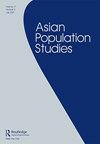冲突和自然灾害能解释巴基斯坦老年男性过剩的原因吗?
IF 1.5
4区 社会学
Q2 DEMOGRAPHY
引用次数: 0
摘要
2015年,巴基斯坦失踪妇女人数约为440万。这一男性过剩的年龄分布(即40岁以上人口)表明,选定的出生队列集体暴露于有害事件(即冲突和自然灾害)可能导致女性相对于男性的死亡率激增。为了分析这一点,本文首先收集了巴基斯坦历史上(自独立以来)发生的冲突和自然灾害引起的性别和年龄分类(尽可能)死亡率统计数据,并评估了它们对年龄人口性别比例(男性/女性)的影响。随后,它分析了按年龄划分的历史性别比例路径,以评估这些事件如何导致偏离路径。分析显示,冲突和自然灾害(单独或综合)对巴基斯坦妇女失踪现象没有影响,因此不能解释该国男子过剩的原因。然而,它指出了巴基斯坦失踪妇女现象的严重性和持久性,特别是在老年人(60岁以上)人口中。它还表明,这种现象在该国未来的老年人口群体中可能会持续下去。本文章由计算机程序翻译,如有差异,请以英文原文为准。
Can conflicts and natural disasters account for the surplus of older men in Pakistan?
ABSTRACT The number of missing women in the population of Pakistan in 2015 amounted to approximately 4.4 million. The age distribution of this male surplus (i.e. in the 40+ population) suggests that the collective exposure of selected birth cohorts to deleterious events (i.e. conflicts and natural disasters) may have precipitated a surge in female vis-a-vis male mortality. To analyse this, this paper first collects gender and age disaggregated (wherever possible) mortality statistics arising from conflicts and natural disasters that have occurred throughout the history of Pakistan (since independence) and evaluates their impact on the sex ratios (male/female) of the population by age. Subsequently, it analyses the historical sex ratio pathway by age to assess how these events may have caused deviations from the pathway. The analysis reveals that conflicts and natural disasters (independently or in the aggregate) have had no impact on the missing women phenomenon in Pakistan and hence cannot explain the surplus of men in the country. Nevertheless, it points to the severity and persistence of the missing women phenomenon in Pakistan, especially among the elderly (60+) population. It also indicates the likely endurance of the phenomenon in future cohorts of elderly population in the country.
求助全文
通过发布文献求助,成功后即可免费获取论文全文。
去求助
来源期刊

Asian Population Studies
DEMOGRAPHY-
CiteScore
3.30
自引率
14.30%
发文量
12
期刊介绍:
The first international population journal to focus exclusively on population issues in Asia, Asian Population Studies publishes original research on matters related to population in this large, complex and rapidly changing region, and welcomes substantive empirical analyses, theoretical works, applied research, and contributions to methodology.
 求助内容:
求助内容: 应助结果提醒方式:
应助结果提醒方式:


